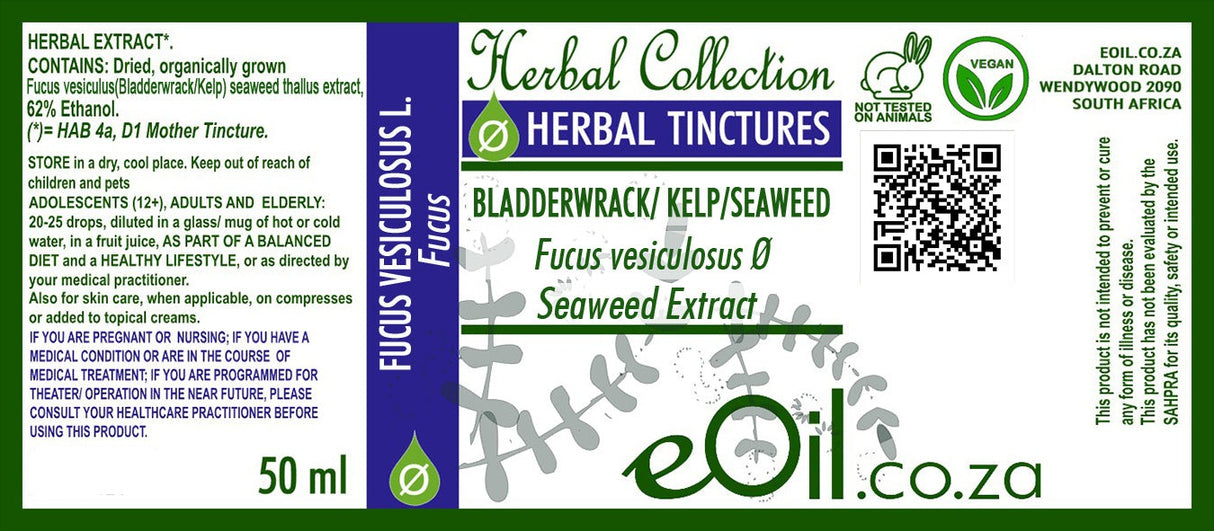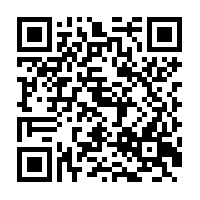Kelp Seaweed Bladderwrack - Herbal Liquid Extract
Kelp Seaweed Bladderwrack - Herbal Liquid Extract - 50 ML is backordered and will ship as soon as it is back in stock.
Description
Description
Understanding Mother Tinctures & Glycerines
Kelp Seaweed Bladderwrack Herbal Liquid Extract tincture is made from Fucus vesiculosus, a brown seaweed found in cold oceans.
Traditionally valued for its natural content of iodine, minerals, and phytochemicals, this alcohol-based tincture retains the seaweed’s unique botanical compounds.
Ethically sourced and vegan-friendly, it’s commonly added to adult wellness routines.
Not for use during pregnancy or with thyroid medication
TRADITIONALLY USED FOR
May help with
anti ulcer
iodine deficiency - thyroid
Goitre
Weight loss
Fatigue - asthenia
Rheumatism
INFORMATION
Source : http://www.wikiphyto.org/wiki/Kelp Bladderwrack
Reference on http://www.wikiphyto.org
Translation in English by Google Translate (go to the page of the source linked | on Chrome cellphones go on the 3 dots on the top right and select translate in your preferred language | on laptop right click your mouse and select option translate when hoovering on the page
plant name
Bladderwrack , bladderwrack , bladderwrack (English)
International Latin denomination
Fucus vesiculosus L., Fucus serratus L.
botanical family
Fucaceae ( Pheophyceae or Phaeophyceae )
Description and habitat
- Brown algae, with flat fronds, usually forked, provided with natural floaters, about 1 meter long
- Clinging to the rocks by a black disc
- North Atlantic and Pacific cold waters
- The detached seaweed is rejected on the coasts in the form of "seaweed"
History and tradition
- It has various uses: fuel, it is used in livestock feed and as agricultural fertilizer (source of iodine and potash), which is of economic interest
- There are four families of algae, green (Chlorophyceae), brown (Pheophyceae), red (Rhodophyceae) and blue (Cyanophyceae)
- Blue-green algae tend to be terrestrial and very small in size.
Parts used
- Whole plant (thallus)
Dosage forms available
- Thallus tincture
Usual dosages
- Dosages:
- Powder 100 to 250 mg per day
- Fluid extract : 5 to 15 drops per day
- Mother tincture : 20 to 50 drops per day; do not exceed 120 micrograms of iodine (120 to 240 mg of Fucus powder) per day in continuous and prolonged treatment
Composition
Main components of the plant
- Polyphenols with antibiotic activity: fucols and fucophloretols
- Polysaccharides , mucilages : alginic acid (12%), fucoidin , laminarin , fucans , fucose , uronic acids, neutral sugars (galactose and xylose), sulphate. They are divided into three groups including the fucoidans (polysulphated homofucans) which seem the most interesting
- Minerals: iodine (0.05 to 0.1%) in the form of inorganic salts and iodoamino acids, bromine, sodium, magnesium
- Protein (10%) all amino acids (+ tryptophan, phenylalanine and leucine)
- Carotenoids : red pigments ( fucoxanthin )
- Polyphenols ( phlorotannins )
- Vitamines : A, B1, B2, B6, B12, PP, C, D3, E, K et phytohormones : gibbérellines
- Ca, Fe, K, Mg, Na, P and S and in the form of trace elements As, Cd, Co, Cu, Hg, Mn, Ni, Pb and Zn
- The heavy metal content must be a maximum of 10 ppm, and that of cadmium 0.2 ppm
Main components of buds or young shoots
Main components of essential oil
Properties
Plant properties
- Anti-ulcer: alginic acid and alginates are polysaccharides obtained from brown algae, which turn into a viscous and frothy colloidal solution (gel) on contact with acidic gastric juice. They must be taken after meals, and thus form a floating mechanical barrier preventing acid or bile reflux into the esophagus.
- Anti-collagenase and anti-elastase activity [1]
- Polysaccharides are immunostimulants ( laminarin ), especially sulfated polysaccharides ( fucoidans ) [ 2] , and antitumor [3]
- Some polysaccharides and oligosaccharides stimulate plant defense mechanisms against various pathogens [4]
- Iodine stimulates the production of thyroid hormones
- Alginates are used as local haemostatics (epistaxis, minor cuts)
Bud properties
Properties of essential oil
Indications
Indications of the whole plant (phytotherapy)
- Goitre (obsolete use due to the great variability of iodine content) but interesting iodine intake for mild thyroid deficiencies
- Weight loss cures (acceleration of the metabolism by the contribution of iodine), but caution in the long-term use
- Fatigue, asthenia, rheumatism
- We can reasonably give an approximation of content of 0.5 to 1 microgram of iodine per milligram of Fucus (1 ‰, which facilitates the calculation)
- These dosages can be increased if taken for a short period (max. 1 month)
- The volatile products do not pass into the extracts, therefore the iodine does not pass into the extracts: use the powder
- Indications :
- Iodine deficiencies, regional iodine insufficiency, soft goiter from thyroid hypometabolism (2 courses of three months per year)
- The recommended daily intake of iodine being 150 micrograms, it is not recommended to consume more than 250 mg of Fucus powder over the long term or equivalent galenic forms (fluid extract)
- Severe hypothyroidism with upper TSH limit, lower T4L limit, without antithyroglobulin or antithyroperoxidase autoantibodies: continuous treatment for one year, monitor hormonal assays every quarter (associate with Avena sativa )
- Lymph node inflammation, states of fatigue, convalescence, senescence, weight gain on the ground of hypometabolism: dose doubled over a maximum of one month, do not repeat before 6 months
- Gastritis and ulcers ( alginic acid )
Indications of the bud (gemmotherapy)
Specific indications of essential oil (aromatherapy)
Known or suspected mode of action
- Alginic acid consists of two uronic acids , D-mannuronic acid and L-glycuronic acid , present as salts
- Insoluble in water, salts of alginic acid give viscous colloidal solutions in the presence of Ca++ ions
Usual formulations
Regulations
- French Pharmacopoeia list A (thallus)
Possible side effects and precautions for use
- Not recommended in case of pregnancy and breastfeeding
- Contrindications :
- Hyperthyroïdies
- HTA, tachycardies, angor
- Iodine hypersensitivity
- Hyperthyroidism can be caused with doses higher than 150 micrograms of iodine in a prolonged way (recommended daily dose)
Bibliographic references
- Go↑ Thring TS, Hili P, Naughton DP. Anti-collagenase, anti-elastase and anti-oxidant activities of extracts from 21 plants. BMC Complement Altern Med. 2009 Aug 4;9:27. doi: 10.1186/1472-6882-9-27. PubMed PMID 19653897
- Go↑ Kim SK, Li YX. Medicinal benefits of sulfated polysaccharides from sea vegetables. Adv Food Nutr Res. 2011;64:391-402. doi: 10.1016/B978-0-12-387669-0.00030-2. PMID 22054963
- Go↑ Lee H, Kim JS, Kim E. Fucoidan from seaweed Fucus vesiculosus inhibits migration and invasion of human lung cancer cell via PI3K-Akt-mTOR pathways. PLoS One. 2012;7(11):e50624. doi: 10.1371/journal.pone.0050624. PMID 23226337
- Go↑ Vera J, Castro J, Gonzalez A, Moenne A. Seaweed polysaccharides and derived oligosaccharides stimulate defense responses and protection against pathogens in plants. Mar Drugs. 2011 Dec;9(12):2514-25. doi: 10.3390/md9122514. PMID 22363237
- Morel J.-M., Perrey F., Lejeune R., Goetz P. Fucus vesiculosus L. Medical monograph. Phytotherapy, Vol 3, Number 5 / October 2005, 218-221. [1]
- Pilar Rupérez, Oussama Ahrazem, J. Antonio Leal. Potential Antioxidant Capacity of Sulfated Polysaccharides from the Edible Marine Brown Seaweed Fucus vesiculosus. J. Agric. Food Chem., 2002, 50 (4), pp 840–845
- Lordan S, Ross RP, Stanton C. Marine bioactives as functional food ingredients: potential to reduce the incidence of chronic diseases. Mar Drugs. 2011;9(6):1056-100. PMID 21747748 Texte intégral
CAUTION
Store in a cool, dry place, away from light. Keep tightly closed, away from the reach of Children and pets.
Do not exceed the daily dose.
This product is not intended to prevent or cure any form of illness or disease.
If you are pregnant or nursing ; If you have a medical condition or are in the course of medical treatment ; If you are programmed for theater/operation in the near future, please consult your healthcare practitioner before using this product.
This product cannot replace a varied and balanced diet and a healthy lifestyle.
This product has not been evaluated by the SAHPRA for its quality, safety or intended use.
For More Information please check our General Safety Herbal products Page

Kelp Seaweed Bladderwrack - Herbal Liquid Extract - 50 ML is backordered and will ship as soon as it is back in stock.





